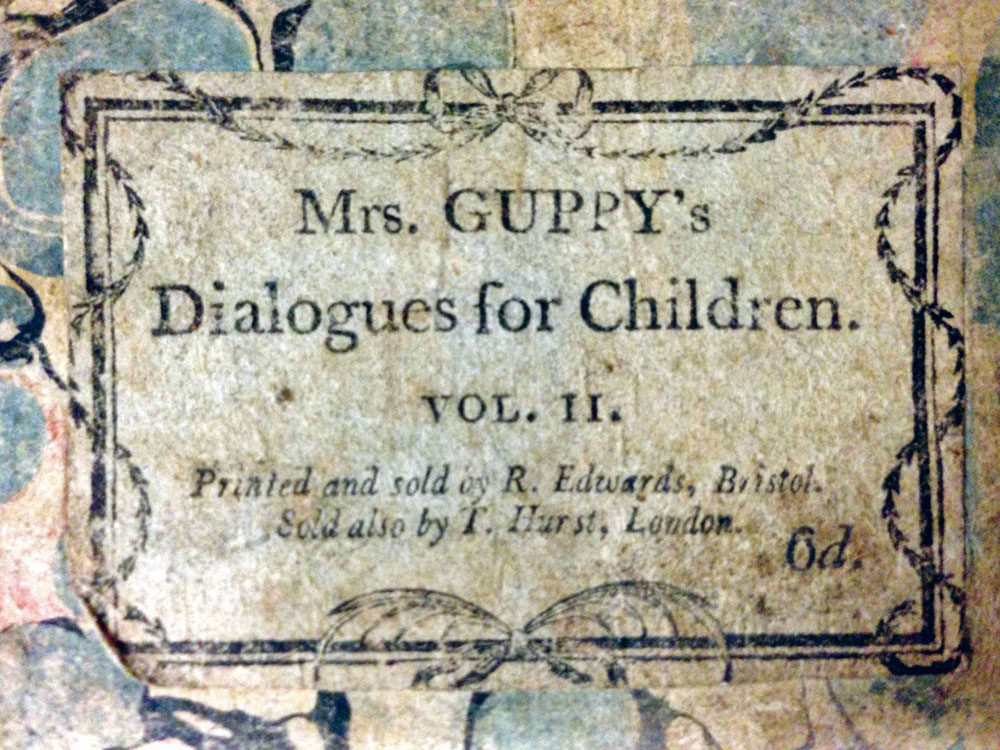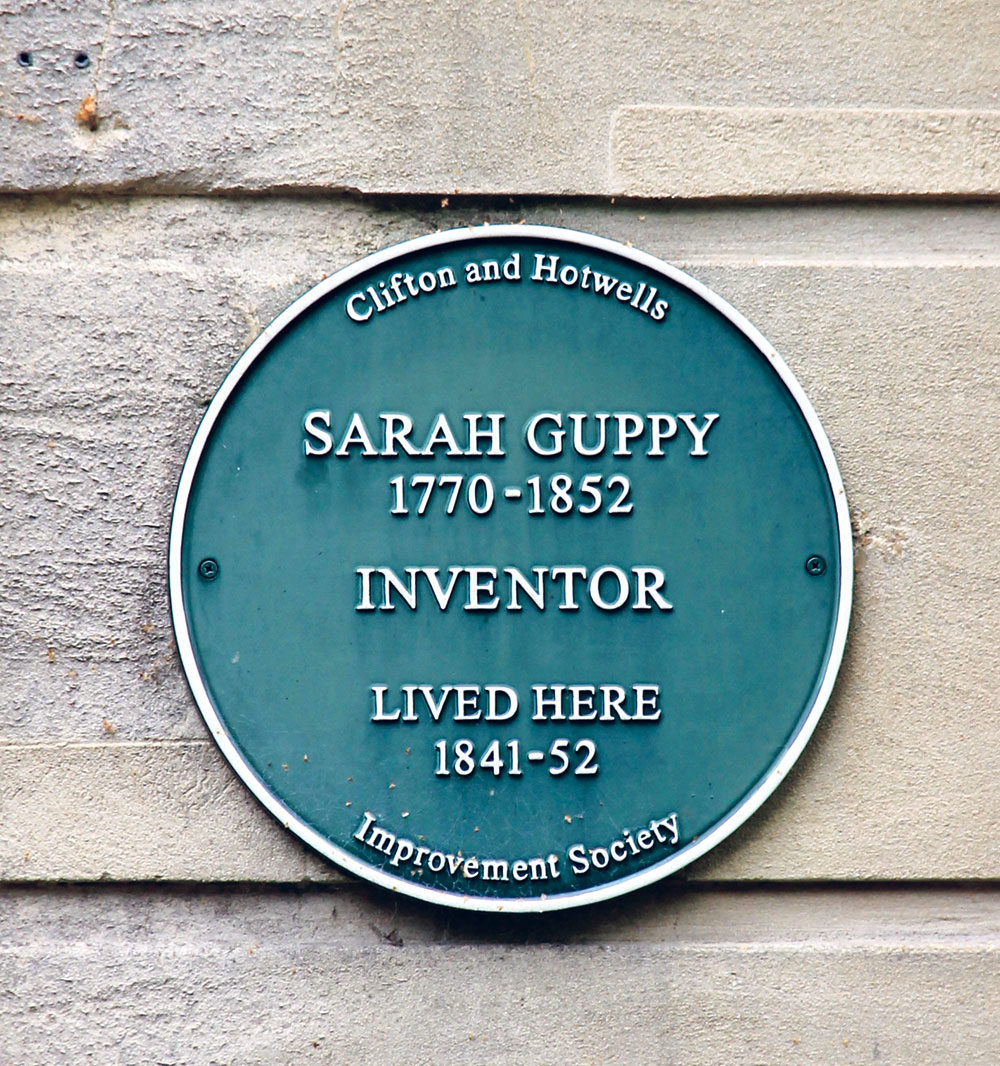In recent years, the name Sarah Guppy has emerged from obscurity as it has become increasingly clear that she was a woman far ahead of her time. Crucial to this rehabilitation has been a play about her, performed to great acclaim by Show of Strength Theatre Company, alerting Bristolians to just how extraordinary she was.
It isn’t as though she wasn’t well known when she was alive – Sarah Guppy was the sort of person you couldn’t really ignore. Formidable, charming, persuasive, impulsive, determined, but above all indefatigable, with a passion for improving the lives of those around her, she was by turns social reformer, writer, philanthropist, businesswoman and engineer. Above all, though, she steadfastly refused to conform to received notions of female propriety in Regency and early Victorian England.
Despite her close association with Bristol, she didn’t live in the city until she was 25. She was born in 1770 – as Sarah Beach – in Birmingham, where her father was a brass founder on Park Street in Digbeth. In 1795, she married Samuel Guppy, 18 years her senior, who was also a brass founder, but by the time of his marriage was running the Patent Pure Copper Sheathing Nail Company.
This was located in a factory on the Grove in Bristol, which backed onto his home at 34 Queen Square. In keeping with the name of his company, he patented two nail-making processes, the second of which, in 1804, brought him over £20,000 from a contract for supplying nails to the Admiralty. Sarah, who dealt with many aspects of the business, negotiated the contract. It seems likely, given that both patents date from after their marriage, that she also helped to come up with the ideas for them.
Sarah had six children, and drew on her experiences to write Mrs Guppy’s Dialogues for Children, which was published in 1800, with the proceeds going to a girls’ charity school. It was engineering for which she really had a passion – and a flair – however. On 27 July 1811, the Bristol Journal reported that, ‘Mrs Guppy has been assiduously employed in forming the model of a bridge to be erected across the Avon, from the Hotwells to the opposite side’. So keen was she on the project that she took out a patent for ‘erecting and constructing bridges and railroads without arches or starlings, whereby the danger of being washed away by floods is avoided’. Her solution was to install, on each side of the river, ‘a row of piles, with suitable framing, to connect them together; and behind these … other rows of piles’. ‘Strong metallic chains’ would then be slung across and drawn tight, creating a platform to ‘support … a road or pavement … or for railroads’. The bridge was never built, although it is believed that when Thomas Telford drew up plans for building a suspension bridge across the Menai Strait a few years later, he borrowed the idea of installing parallel rows of piles on either bank from Sarah Guppy.

In 1811, Sarah also wrote to Lord Liverpool with proposals for redesigning Smithfield Meat Market, evincing a concern for animal welfare that would continue throughout her life. The following year, she not only founded a Society for the Reward and Encouragement of Virtuous, Faithful, and Industrious Female Servants but also patented the first of several labour-saving domestic implements – a tea or coffee urn containing a vessel in which an egg could be boiled and fitted with a lid designed to support a plate for keeping food warm. Around this time, a succession of pamphlets, such as one which proposed ‘providing suitable, agreeable and permanent residences for ladies’, also started to appear on a regular basis.
In 1819, after Sarah received a handsome legacy from her father, Samuel closed the factory and the family moved to Arnos Vale. We have very little information about what she got up to over the next few years, although the couple may have become estranged during this time. Samuel died in 1830, however, and the following year Sarah demonstrated that her capacity for invention was undimmed, by patenting a bed for the sickroom. Drawers underneath could be pulled out to form steps up which an invalid could climb into bed. Once there, they could take hold of ropes attached to overhead pulleys to raise or lower themselves ‘and enjoy a degree of exercise unknown to invalids who are condemned to the recumbent posture’.
Through her second son, Thomas, Sarah also got to know Brunel. Thomas was a distinguished engineer as well as co-owner, with his brother Samuel, of a large sugar refinery on Merchant Street in Quakers Friars. He met Brunel when he arrived in Bristol in 1829 to take on the challenge of building a bridge across the Avon Gorge, and the two men became close friends. Thomas was one of the main promoters of the Great Western Railway and became Directing Engineer of the Great Western Steamship Company, overseeing the construction of the SS Great Western and SS Great Britain.
Naturally, Brunel got to know Thomas’s mother, whom he described as ‘a shrewd woman’. There can be no doubt that she would have regaled him with details of the bridge she had patented 20 years earlier. How much of what she told him about parallel rows of piling was incorporated into his design for the bridge at Clifton is unknown, however. What is known is that she was an enthusiastic supporter of the project, writing in the Bristol Mercury that it was ‘a most suitable investment for ladies’. She also bought £5,000 worth of shares in the GWR, and took an active interest in the enterprise, firing off a series of letters in 1841 suggesting ways in which ‘some disagreeables in some part of the railway’ could be remedied.
In 1837 she remarried. Her new husband, Charles Eyre Coote, cousin to the late Lord Castle-Coote, was 28 years her junior. Despite his aristocratic connections, he turned out to be an impecunious gambler who soon started to run through his wife’s inheritance. In 1842, the couple moved to 7 Richmond Hill, opposite the Victoria Rooms in Clifton. Sarah was still wealthy enough to buy the houses on either side, however, and the tract of land opposite, where a nursery was established. The range of her interests and the focus of her campaigns also remained as eclectic as ever. In 1841, she presented a paper to the Royal Agricultural Society on the care of sheep and the prevention of foot-rot, and in 1844 she took out a patent for ‘improvements in caulking ships and other vessels’. The new designs she came up with at this time also included a portable stove, a candlestick which prolonged the life of candles and a fire hood for a stove which she dubbed the ‘cook’s comforter’.
When she died in 1852, aged 81, the Bristol Mercury described her as ‘a lady of a most active and enterprising mind … ever animated by a strong desire to be of service to the age in which she lived. The study of mechanics and chemistry and of the science of agriculture engaged much of her attention, and if it cannot be said of her that she perfected many important improvements, it may be truly conceded that she laid the groundwork for others to build upon.’
She was soon forgotten, however, her role as a trailblazer for women engineers ignored for almost a century and a half. Finally, though, her long overdue rehabilitation got under way. In 2006, a plaque was unveiled at 7 Richmond Hill, by Nicholas Guppy, a descendant. Ten years later, in 2016, she made it into the august pages of the Oxford Dictionary of National Biography. Then, following extensive research into her life by Sheila Hannon, Show of Strength Theatre Company premiered Sarah Guppy: The Bridge, The Bed, The Truth, bringing her remarkable story to life.
On 25 March this year, a ceremony was held in St Andrew’s Churchyard, Clifton, where Sarah had been laid to rest 171 years earlier. After falling into poor condition, her memorial had been restored and the service to mark its reinstatement was led by the Very Reverend Dr Mandy Ford, Dean of Bristol Cathedral. It was attended by Paula O’Rourke, the Lord Mayor of Bristol, Peaches Golding, the Lord Lieutenant of Bristol, and Sheila Hannon, the guiding force behind the restoration. Also present were some of Sarah’s descendants, including her fourth great-grandson, Chris Curling, who gave the opening speech.
Recognition of her association with Brunel has also come from Swindon’s STEAM museum, where an exhibition entitled Great Women’s Railway: In a Man’s World, which opened in April, features Sarah alongside other female pioneers in science and engineering.
It may have been a long time coming, but Sarah Guppy is finally receiving the recognition she deserves. As Stuart Burroughs, director of the Museum of Bath at Work and chairman of the Bristol Industrial Archaeological Society, puts it, ‘in the case of Sarah Guppy, we have a combination of invention, drive and confidence which makes her, with hindsight and in her own time, a worthy pioneer and an unstoppable force – to whom male inventors may be compared’.



